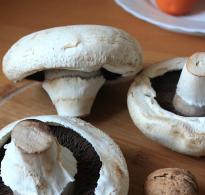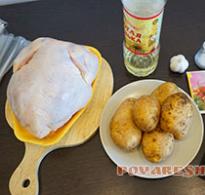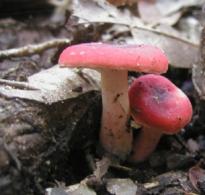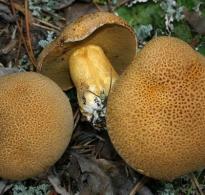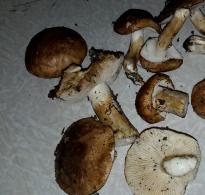The role of recipe components in dough formation. The main components of bread dough and their effect on the dough
In addition to flour, the recipe for most flour confectionery products includes sugar, fats, starch, milk and dairy products, egg products, molasses, invert syrup, raising agents, and flavorings. Most products include water in the dough. Some products contain salt.
The effect of sugar is due to its dehydrating properties. In an aqueous solution, sugar molecules are covered with hydration shells. At a temperature of 20 °C, sucrose molecules bind and hold 8...12 water molecules. Shells increase molecular volume, reducing the rate of diffusion and osmotic swelling of proteins. With an increase in sugar in the dough, the amount of free water in the liquid phase of the dough decreases to a greater extent and the swelling of flour colloids is limited.
The sugar content in the dough affects the structure of the dough, its structural and mechanical properties and the quality of products. Sugar makes the dough soft and sticky. With a high sugar content, the adhesion (sticking) of the dough to the working surfaces of machines (rolling, forming mechanisms, to the steel belt of the oven chamber) increases. The dough pieces spread when baking. With a high sugar content and the absence of fat in the recipe, the resulting products are excessively hard.
Thus, sugars in dough and products play not only a nutritional role, but also have technological significance. They limit the swelling of proteins and increase the plasticity of the dough.
The quality of the dough is influenced by the size of the sugar particles. To obtain a plastic dough with a low water content, crushed granulated sugar - powdered sugar - should be used. This ensures that all sugar is soluble in water. Otherwise, the quality of the products deteriorates due to the presence of undissolved crystals on the surface. Thus, using the properties of sugar, it is possible to regulate the degree of swelling of flour proteins and starch.
Fats also regulate the degree of swelling of flour colloids, but their mechanism of action is different. Fats, adsorbed on the surface of colloidal particles, weaken the mutual connection between them and prevent the penetration of moisture, increasing the content of the liquid phase of the dough. The dough becomes more flexible. The thinner the fat films and the more of them in the dough, the more porous and fragile the structure of the resulting products. Therefore, it is recommended to introduce fats into the dough in the form of a finely dispersed emulsion.
The quality of products is influenced by the chemical composition of fat and its physical state. Fats must be plastic. In this case, they cover the flour particles with the thinnest films. If the melting point of fat exceeds the temperature of the dough, then it remains in the dough in the form of solid particles and its positive effect on the properties of the dough is weakened.
Fats that retain plasticity over a wide temperature range have an advantage. This is achieved by combining solid and liquid fats with different melting points. Liquid vegetable oil is released from products.
Thus, fats, by reducing the swelling of flour colloids, increase the plasticity of the dough, and give the finished products layering, friability, and porosity. As the amount of fat increases, the dough becomes loose and crumbly.
Milk and dairy products (whole milk, condensed milk, powdered milk, dry cream, etc.) contain well-emulsified fat that is easily adsorbed by gluten, due to which this type of raw material affects not only the taste, but also increases the plasticity of the dough.
Eggs and eggs contain two surfactants: egg albumin (egg white) and lecithin phosphatides (egg yolk). Other egg products contain either egg albumin or phosphatides-lecithin. Egg albumin serves as a good foaming agent and promotes the formation of a porous, fixed structure, possibly without the use of other disintegrants. When producing an emulsion, yolk lecithin acts as an emulsifier, dispersing the fat included in the product formulation.
Both substances improve the nutritional value of products and form taste and aroma qualities.
Molasses and invert syrup, containing reducing substances, increase the hygroscopicity of products and their wetness.
When more than 2% molasses is added to long-lasting cookies, the dough becomes more moist and sticky.
When baking dough pieces, reducing sugars interact with amino acids to form dark-colored substances - melanoidins. The reaction rate increases in an alkaline environment; the reaction products at low concentrations color the products golden yellow.
Leavening agents, included in the recipe of most products, perform the main technological role: they loosen dough or dough pieces and ensure the production of products with a porous structure. There are three known methods of loosening confectionery dough: chemical (using salts); biochemical (using yeast); physical.
In the production of flour confectionery products, the chemical method is used as the main method of loosening dough. It is used in the production of products with a high content of sugar and fat, which have a depressing effect on yeast.
The biochemical method is used to produce products with a lower sugar and fat content (crackers, biscuits, muffins).
The physical method is that the dough is saturated with air or gas during the dough formation process. During baking, the bubbles of the gaseous phase expand and form a porous structure (sponge dough and semi-finished product, semi-finished protein product).
The chemical method of loosening dough uses alkaline, alkaline-acid and alkali-salt leavening agents.
Alkaline disintegrants: sodium bicarbonate (sodium bicarbonate, baking soda), ammonium carbonate, ammonium carbonate salt.
Loosening of the dough with chemical leavening agents occurs during the baking process of dough pieces (sugar cookies, hard cookies, wafer sheets, gingerbread cookies). When the temperature reaches 60°C, ammonium carbonate decomposes:
(NH^COj = 2NHj + CO2 + H20.
About 82% of gaseous substances (ammonia, carbon dioxide) and about 18% of water vapor are released.
Ammonium carbonate salt, used as a substitute for ammonium carbonate, upon decomposition produces the same gaseous substances, but in smaller quantities:
Where x is the amount of water per batch, kg; A is the desired moisture content of the dough, %; B - mass of raw materials per batch (without added water), kg; C - mass of dry substances of raw materials, kg.
Depending on the water-absorbing ability of flour and the product recipe, the dosage of water under production conditions is specified for each type of product. Regulation of dough humidity is carried out only at the beginning of kneading, until the dough structure has formed.
The water absorption capacity of flour depends on the amount of sugar in the dough. When adding 1% sugar it decreases by 0.6%.
Thus, the raw materials used in the production of flour confectionery products, as a rule, play not only the role of flavoring agents, but also a technological role, influencing the physicochemical properties of the dough and products.
Confectionery dough, unlike the simplest one, which is formed from flour and water, consists of a large number of components. The cookie recipe, for example, includes up to 12 types of raw materials, which affect the state of proteins and starch, the structure of the dough and finished products.
First of all, the properties of the dough are determined by the quality of flour, the quality and quantity of gluten. To produce a wide range of confectionery products, flour with different gluten qualities is required. For long-lasting cookies, crackers, and wafer sheets, flour with weak gluten is required; for sugar cookies - flour with weak or medium gluten; For choux and puff pastry, flour with strong gluten is needed.
The second most important component of the dough is sugar in the form of granulated sugar or powdered sugar. Sugar has an effect on the dough due to its dehydrating properties. In an aqueous solution, sugar molecules are covered with hydration shells. At a temperature of 20 ° C, sucrose molecules bind and hold 8 - 12 water molecules. Shells increase molecular volume, reducing the rate of diffusion and osmotic swelling of proteins. With an increase in the amount of sugar, the amount of free water in the liquid phase of the dough decreases and the swelling of flour colloids is limited.
Sugar in dough also affects the structure of the dough, rheological properties and quality of products. The dough becomes soft, viscous, plastic. With a high sugar content, the adhesion (sticking) of the dough to the working surfaces of machines (rolling, forming, to the steel belt of the oven chamber) increases. When baking, the dough pieces spread. The high sugar content and lack of fat in the recipe make the products excessively hard.
The quality of the dough is influenced by the size of the sugar particles. To obtain a plastic dough with a low water content, powdered sugar should be used. This ensures that all sugar is soluble in water. Otherwise, the quality of the products deteriorates due to the presence of insoluble crystals on the surface.
The degree of swelling of flour colloids is also regulated by fats, but their mechanism of action is different. Fats, adsorbed on the surface of colloidal particles, weaken the mutual connection between particles, prevent the penetration of moisture, increasing the content of the liquid phase of the dough. The dough becomes more plastic. The thinner the fat films and the more of them in the dough, the more porous and fragile the structure of the resulting products. Therefore, it is advisable to use fats in a plastic state or add them to the dough in the form of a finely dispersed emulsion.
Fats that retain plasticity over a wide temperature range have an advantage. This is achieved by combining solid and liquid fats with different melting points. Liquid vegetable oil is released from products.
The plasticity of the dough is influenced by milk (whole, condensed, dry, dry cream) and dairy products included in the recipes of flour confectionery products. This is explained by the fact that they contain well-emulsified fat, which is easily adsorbed by gluten. Dairy raw materials have a positive effect on the taste of products.
They improve the nutritional value of the dough, shape the taste and aromatic qualities of eggs and egg products (melange, white, yolk). Eggs contain two surfactants: albumin in the white and lecithin in the yolk. Egg albumin serves as a good foaming agent and promotes the formation of a porous fixed structure without the use of raising agents; it is widely used in the production of airy semi-finished products for cakes and pastries. Lecithin in the emulsion acts as an emulsifier, dispersing the fat included in the product formulation, and ensures the stability of the emulsion.
The confectionery dough recipe includes a small amount of invert syrup or molasses, with which hygroscopic reducing substances are added that increase the wetness of the products. With an increase in the amount of molasses (more than 2% in hard cookies), the moisture and stickiness of the dough increases.
To obtain a porous dough structure, leavening agents of various natures (chemical, biological) are included in its recipe. The main method adopted is the chemical method of loosening the dough. It is used in the production of products with a high content of sugar and fat, which have a depressing effect on yeast. Depending on the type of product, the recipes provide for the use of sodium bicarbonate (0.4 - 0.7%) and ammonium carbonate (0.5 - 0.8%). It is allowed to vary the amount of baking powder depending on the quality of flour. In the production of dome-shaped gingerbread, the dose of ammonium carbonate exceeds the dose of sodium bicarbonate by more than 2 times.
Leavening agents give products an alkaline reaction, which causes caramelization of sugars during baking. This leads to the formation of substances in the dough that give the products a yellowish tint and impart a specific taste. If there is an excess of leavening agents, an unpleasant taste and odor will appear.
Yeast allows you to eliminate the disadvantages of chemical leavening agents and obtain a dough that has an acidic reaction.
Table salt is included as a flavoring agent in the confectionery dough (0.2 - 0.8% of the flour weight). Salt increases the gelatinization temperature of starch. In small doses, salt increases the swelling of flour proteins, improves the properties of the dough, and increases its strength.
Water is needed to swell flour colloids and dissolve its constituent parts. The amount of water depends on the type of dough and product recipe, and on the water absorption capacity of the flour.
Fatty products added to the dough play a critical role in shaping the rheological properties of the dough, the nutritional value of baked goods and preserving their freshness. The rheological properties of wheat dough depend mainly on the presence of a gluten framework in it, which gives the dough elasticity and elasticity. Adding fat to the dough up to 3% of the total mass of flour improves the rheological properties of the dough, increases the volume of bread, and increases the elasticity of the crumb. During dough fermentation, a certain proportion of fats interacts with gluten proteins and flour starch. Such complexes improve the rheological properties of the dough and increase its gas-holding capacity.
It has been proven that the total content of fatty products does not change during the preparation of bread, but the proportion of free lipids decreases, and the share of bound lipids increases. The degree of interaction of fats with dough components increases when fat is emulsified before kneading dough and surfactants are added to the emulsion. Fats, which include polyunsaturated fatty acids, strengthen gluten and have a beneficial effect on the volume of bread. Lipids have a significant impact on the quality of gluten during dough kneading and fermentation. It has been established that when kneading dough, the proportion of bound lipids increases significantly at the expense of free ones. The formation of lipoprotein complexes in itself has a significant strengthening effect on the rheological properties of the dough.
No less important is the role of lipids, primarily unsaturated fatty acids, in the oxidative processes occurring in dough. Gluten is the basis of wheat dough, determining its specific physical properties (extensibility and elasticity), and has a great influence on the quality of bread. Fatty substances are always present in gluten. Their content ranges from 0.7 to 13.2% of gluten dry matter. The close connection between the quality of gluten and the composition of the fatty fraction of flour, as well as the constant presence of significant amounts of bound lipids in gluten, have led many researchers to the idea of it as a protein-lipid complex. Fatty substances, distributed in a thin layer over the structural elements of gluten, facilitate their sliding relative to each other. It is as if the gluten strands and starch grains are “lubricated” by the added fat, and the thinner the fatty substances are emulsified, the more evenly they are distributed in the dough, improving its rheological properties.
Lipids introduced during dough kneading enter into exchange reactions with flour lipids, which interact with gluten protein, and change the properties of this complex, and, consequently,
gluten It has been established that both saturated and unsaturated fatty acids have a strengthening effect on gluten, and with a decrease in the length of the carbon chain and an increase in the degree of unsaturation of fatty acids, their strengthening effect on gluten increases.
The interaction of fatty acids with proteins can be caused by the aliphatic radical CH3–CH2–CH2–, the ethylene group –CH=CH– and the carboxyl group –COOH. The latter can interact, under appropriate conditions, with the side and terminal amino groups of polypeptides to form compounds such as alkylamines.
The action of various lipid compounds manifests itself in different ways:
- linoleic acid, which makes up the main part of flour fatty acids, forms peroxide compounds that participate in the oxidation of sulfhydryl groups of proteins;
- oleic acid and saturated fatty acids together with gluten proteins form lipoprotein complexes;
- Phospholipids and glycerides also form complexes with protein.
The formation of such complexes leads to a change in the rheological properties of gluten. In controlling the processes occurring during the preparation of bread, the substances included in the composition play an important role.
recipe components of the dough, as well as their interaction with each other. The strength of gluten molecules depends on the various types of bonds and interactions involved in its formation.
When flour and water are kneaded, gluten protein forms an elastic “framework,” which is the basis of the physical structure of the dough.
Under the influence of proteolytic and redox enzymes, various waste products of yeast, lactic acid bacteria and other microorganisms, as well as various
components of flour and dough ingredients, changes occur in the structure of the gluten protein complex, leading to a decrease in the mechanical strength of gluten.
Based on the above, the following conclusions can be drawn:
- lipids have a significant impact on the quality of gluten and the rheological properties of the dough;
- during kneading and during the fermentation of the dough, hydration of gluten proteins occurs, and then their gradual disaggregation, which leads to relaxation of the dough.
This process is prevented to a certain extent by the lipid complex of flour. The oxidation products of fatty acids oxidize the sulfhydryl groups of proteins, which in this case produce new disulfide bonds.
The resulting disulfide bonds stabilize existing ones. All this reduces the disaggregation of gluten and the degree of peptization of proteins. These experimental facts made it possible to put forward a hypothesis about the mechanism of a reversible redox process, during which unsaturated fatty acids play the role of an oxygen carrier without undergoing any transformations at the end of each cycle.
However, it has not yet been possible to identify the intermediate product of this reaction.
Wheat flour contains about 2% lipids (tri-, di- and monoglycerides, fatty acids, phospho- and glycolipids). Of this amount, from 20 to 30% is in a bound state. It is these bound lipids, primarily phospholipids included in the macrostructure of the gluten protein, that most significantly influence the rheological properties of the gluten framework in the dough, the rheological properties of the dough and, consequently, the baking properties (strength) of flour and the quality of bread.
Approximately three-quarters of the fatty acids in grain lipids are unsaturated acids, including about half linoleic acid. It has been established that kneading dough sharply increases the proportion
bound lipids (from about 30% in flour to 90% or more in dough). In this case, phospholipids are primarily bound by gluten proteins. This is explained by the fact that in the process of dough making, lipids interact with proteins and carbohydrates of the dough, forming complex complexes and compounds that significantly affect the structural and mechanical properties of the dough and improve the quality of the finished products.
Not only the lipids of the flour itself, but also the fats added to the dough during its kneading, are largely associated with proteins, starch and, possibly, other components of the solid phase of the dough. Some of the fat present in the dough in a liquid state may be present as an emulsion in the liquid phase of the dough.
It is known that adding fats, especially those in a liquid state, to the dough makes the dough somewhat more liquid. At the same time, the stickiness of the dough is reduced, and the dough with fat passes through the working parts of the dough cutting equipment better.
Some researchers believe that the change in the structural and mechanical properties of the dough is the result of the penetration of fatty products between the structural elements of the dough (gluten strands and starch grains), as a result of which the dough becomes softer. At the same time, the fat itself does not undergo significant changes.
Other researchers believe that there is a physicochemical interaction between fat and the structural components of the dough. It is expressed in various forms of lipid-protein interaction, lubrication of the structural elements of the dough, especially gluten proteins, which facilitates their sliding during fermentation and baking, as well as in increasing the gas-holding capacity due to the fact that fat fills (clogs) the voids formed between components of the dough, and prevents gas evaporation during the technological process. At the same time, fat significantly increases the free water content in the dough due to the formation of hydrophobic layers, which reduce the hydration capacity of starch and proteins, as a result of which the consistency of the dough becomes weaker. Fats or solid fractions of a fatty product with a melting point higher than the dough temperature do not bind to the components of the solid phase of the dough, but remain in it in the form of solid particles that will begin to melt only when the dough piece is heated during the baking process.
Adding small amounts of fat to the dough, which has a melting point higher than the temperature of the dough, has virtually no effect on the rheological properties of the dough and on the condition of the dough pieces at the stage of final proofing of the dough.
The effect of this fat on the quality of bread begins to appear only during the baking process, when the dough, as a result of heating, reaches the melting temperature of the fat.
The increase in the volume of the dough piece in the first period of the baking process occurs more intensely and over a longer period of time than for products without adding fat. As a result, the volume of bread with the addition of such fat is significantly greater than that of the control sample.
Obviously, fat improves the gas-holding capacity of the dough at this stage of the process and at the same time slows down the formation of a hard dehydrated layer on the surface of the baked dough piece - crust.
Veronika Tarasova, Moscow State University of Food Production 21 22 23 24 25 26 27 28 29 ..
5.2. The influence of other recipe components on the properties of dough and confectionery products
In addition to flour, the recipe for most flour confectionery products includes sugar, fats, starch, milk and dairy products, egg products, molasses, invert syrup, raising agents, and flavorings. Most products include water in the dough. Some products contain salt.
Effect of sugar due to its dehydrating properties. In an aqueous solution, sugar molecules are covered with hydration shells. At a temperature of 20 °C, sucrose molecules bind and hold 8...12 water molecules. Shells increase molecular volume, reducing the rate of diffusion and osmotic swelling of proteins. With an increase in sugar in the dough, the amount of free water in the liquid phase of the dough decreases to a greater extent and the swelling of flour colloids is limited.
The sugar content in the dough affects the structure of the dough, its structural and mechanical properties and the quality of products. Sugar makes the dough soft and sticky. With a high sugar content, the adhesion (sticking) of the dough to the working surfaces of machines (rolling, forming mechanisms, to the steel belt of the oven chamber) increases. The dough pieces spread when baking. With a high sugar content and the absence of fat in the recipe, the resulting products are excessively hard.
Thus, sugars in dough and products play not only a nutritional role, but also have technological significance. They limit the swelling of proteins and increase the plasticity of the dough.
The quality of the dough is influenced by the size of the sugar particles. To obtain a plastic dough with a low water content, you should
use crushed granulated sugar - powdered sugar. This ensures that all sugar is soluble in water. Otherwise, the quality of the products deteriorates due to the presence of insoluble crystals on the surface. Thus, using the properties of sugar, it is possible to regulate the degree of swelling of flour proteins and starch.
Fats they also regulate the degree of swelling of flour colloids, but their mechanism of action is different. Fats, adsorbed on the surface of colloidal particles, weaken the mutual connection between them and prevent the penetration of moisture, increasing the content of the liquid phase of the dough. The dough becomes more plastic. The thinner the fat films and the more of them in the dough, the more porous and fragile the structure of the resulting products. Therefore, it is recommended to introduce fats into the dough in the form of a finely dispersed emulsion.
The quality of products is influenced by the chemical composition of fat and its physical state. Fats must be plastic. In this case, they cover the flour particles with the thinnest films. If the melting point of fat exceeds the temperature of the dough, then it remains in the dough in the form of solid particles and its positive effect on the properties of the dough is weakened.
Fats that retain plasticity over a wide temperature range have an advantage. This is achieved by combining solid and liquid fats with different melting points. Liquid vegetable oil is released from products.
Thus, fats, by reducing the swelling of flour colloids, increase the plasticity of the dough, and give the finished products a layered appearance. friability, porosity. As the amount of fat increases, the dough becomes loose and crumbly.
Milk and dairy products (whole milk, condensed milk, powdered milk, dry cream, etc.) contain well-emulsified fat that is easily adsorbed by gluten, due to which this type of raw material affects not only the taste, but also increases the plasticity of the dough.
Eggs and melange contain two surfactants: egg albumin (egg white) and phosphatides-lecithin (egg yolk). Other egg products contain either egg albumin or phosphatides-lecithin. Egg albumin serves as a good foaming agent and promotes the formation of a porous, fixed structure, possibly without the use of other disintegrants. When producing an emulsion, yolk lecithin acts as an emulsifier, dispersing the fat included in the product formulation.
Both substances improve the nutritional value of products and form taste and aroma qualities.
Molasses and invert syrup, containing reducing substances, increase the hygroscopicity of products and their wetness.
When more than 2% molasses is added to long-lasting cookies, the dough becomes more moist and sticky.
When baking dough pieces, reducing sugars interact with amino acids to form dark-colored substances - melanoidins. The reaction rate increases in an alkaline environment; the reaction products at low concentrations color the products golden yellow.
Sugar makes the dough soft and sticky; if there is an excess of it, the dough sticks to the working parts of the machines, and the workpieces blur during baking. An increased amount of sugar in fat-free products makes them excessively hard.
Fats make the dough more plastic, and the finished products flaky and crumbly. As the amount of fat increases, the dough becomes loose and crumbly.
Starch gives the dough plasticity, and the products acquire good wetness and fragility. During the baking process, dextrins are formed on the surface of the products, which in a dehydrated state give the products, especially long-lasting cookies, a shiny surface.
Dairy products improve the physical properties of dough and the taste of products due to the presence of well-emulsified fat, which is easily adsorbed by gluten.
Egg albumin, being a good foaming agent, imparts porosity to products and helps to fix the structure. For some types of baked goods, to which a significant amount of egg products is added, chemical leavening agents are not used at all, since the porosity obtained due to egg albumin is quite sufficient.
Yolk lecithin emulsifies fats used in kneading dough. The dough for long-lasting varieties of cookies includes up to 3.5%, sugar - up to 4.5% eggs or melange.
Molasses, invert syrup and honey increase the wetness and hygroscopicity of products. In addition, they color the surface of the products golden yellow due to the decomposition of monosaccharides under the influence of high temperature during the baking process. Molasses is provided for in the recipes for the production of long-lasting cookies within 2%. The use of molasses in excess of 2% makes the dough sticky and increases its viscosity.
Chemical leavening agents are chemical compounds that, when decomposed during the baking process, release gaseous substances that leaven the dough.
Most flour confectionery products contain a significant amount of sugar and fat, which have a depressing effect on. Therefore, in most cases, to leaven these products, chemical leavening agents are used rather than yeast. In addition, the use of yeast lengthens the production process and increases losses due to the fermentation of sugar by yeast.
The most common alkaline chemical disintegrants used in industry are sodium bicarbonate and ammonium carbonate.
Sodium bicarbonate (bicarbonate of soda, sodium bicarbonate) decomposes when heated, releasing carbon dioxide according to the following equation:
2NaHC03 = Na2C03 + C02 + H20.
When sodium bicarbonate decomposes, sodium carbonate is formed, which imparts an alkaline reaction to products. Since the decomposition reaction does not proceed to completion, only 50% of carbon dioxide is released, which is involved in loosening the dough.
When decomposed, sodium bicarbonate colors the surface of products yellowish-pink and gives them a specific taste.
When heated, ammonium carbonate decomposes according to the equation
(NH4)2C03 «~ 2NH3 + COjj + H20.
Ammonium carbonate decomposes completely in the oven, releasing about 82% of the gaseous substances involved in loosening the dough. If there is an excess of this leavening agent in products, the smell of ammonia can be felt for a long time.
Most often, recipes call for the use of a mixture of sodium bicarbonate and ammonium carbonate, which reduces the alkalinity of products and avoids the smell of ammonia.

